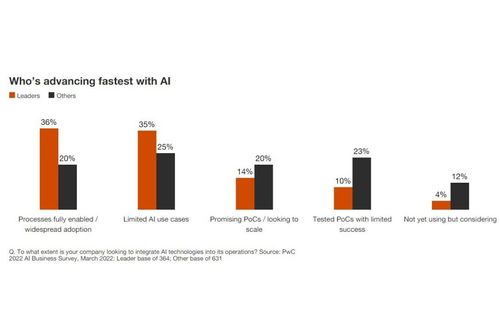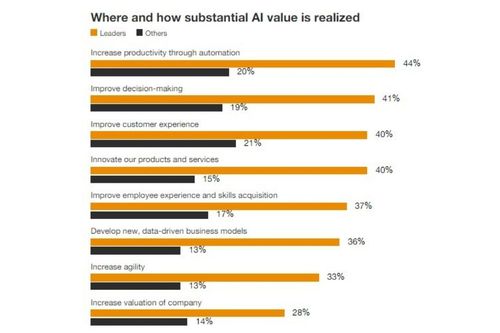A practical approach from PwC’s global AI lead, and the firm's data and analytics partner

A practical approach from PwC’s global AI lead, and the firm's data and analytics partner
In his 2022 letter to shareholders, JPMorgan CEO Jamie Dimon told investors that the financial services giant has spent $100 million since 2017 on AI, machine learning and other technology initiatives to improve its fraud detection systems.
“We know this investment is working,” he wrote. Annual fraud losses are down 14% since 2017 even as transaction volumes increased by nearly 50%. “We estimate that our technology investments alone contributed about $100 million in annual savings.”
Companies are getting more adept at using AI and seeing higher success rates, according to the PwC 2022 AI Business Survey. “AI success is becoming the rule, not the exception,” the report said. Companies are reporting “promising proofs of concept that are ready to scale, active use cases and even widespread adoption of AI-enabled processes.”
Among these companies, those taking the lead in AI also report “significant ROI.”
“This is for real,” said Anand Rao, PwC global AI lead, in an interview with AI Business. But “you need a vision on how you want to transform your business – then AI becomes a good enabler.”
The holistic AI strategy
AI leaders tackle three business initiatives all at once instead of piecemeal: business transformation, systems modernization and enhanced decision-making.
Business transformation is the fundamental rethinking of the company’s strategy, customers, operations and people with an eye toward a business outcome. This bucket encompasses enterprise strategy and digital value creation, Rao said.
For example, PwC worked with a fast food chain client during the pandemic that faced challenges due to fluctuating customer traffic, unstable employee attendance and missing product deliveries.
How can a company plan if “you didn’t know how many people were coming in as customers and you didn’t know how many (employees) will be there? … (and) what to do when a particular ingredient is not available?” Rao asked. Let’s say the avocado shipment did not arrive, can tofu be used instead so the amount of protein in the dish remains the same?
“That’s the level at which companies were essentially working, and AI was helping them,” Rao said.
Systems modernization means adopting newer technology such as the cloud, whether hybrid, private, public cloud and the like. It also includes the internet of things, sensors, blockchain technology and others. Increased productivity through automation, improved customer service, higher agility and the like unlock “substantial AI value,” the report said.
The third is enhanced decision-making. “AI-supported decision-making … can enable you to incorporate and analyze far more information than you (or any human being) could do on their own,” according to the report.
For example, “If I'm an insurance company, I can use images to classify (auto or property) damage. That's much faster, and also maybe better and more effective than getting my entry level people to do it,” Rao said. “You're lifting the game for everyone.”
Figure 1: 
Another example comes from PwC itself when it was trying to figure out how much office space to retain for a hybrid workforce, Rao said.
“One of the biggest challenges is, what do you do with the space? How much space do you need? When we say people can come in anytime, do we expect everyone to come in at the same time on a Friday? Or do we expect only 50% to come? If it is only 50% then we probably don't need 50% of the space.”
PwC started by creating a digital twin of its Boston office and modeled various scenarios such as when only 20% of the people came in, 100% or 50%, Rao said. “How many partners are really going to show up versus associates? Who will have a cubicle? Do we do hoteling (where desks are first come first served)?”
“If people are coming to the office, they're coming more likely for a meeting. So maybe we need to increase the meeting space, reduce the space for cubicles,” Rao said. “All of those different choices were what we were simulating. We were running scenarios: What's the best case? Worst case?”
The data sources were PwC employee cards that people swipe to enter or exit the office, information from the meeting booking system, and data from cameras and sensors that detect if people show up to meeting rooms that they booked.
Rao said PwC started modeling scenarios of one office. “After we saw the utility of that project, we started scaling across multiple locations.”
PwC saved millions from optimizing workspaces, Rao said. “We saved by basically tracking and looking at the utilization, and then leasing specific floors or renegotiating contracts depending on each location. That was done by the real estate team. The modeling enabled them to say which places there is enough demand that we can lease it and which … we should renegotiate.”
Importance of data democracy
Underpinning the AI strategy is data. Accessibility of data is key to success, Bret Greenstein, PwC data and analytics partner, told AI Business. “It starts when you have the mindset that unlocking the data, enabling data science, providing trust of the data (become) your mandates.”
But a lot of CIOs resist giving up control of the data. For decades, data grew organically in siloes and departments inherently do not want to share data with each other. “A lot of legacy technologies are geared towards these data siloes and data islands (where they) apply access controls and security and just make it harder to get access … to keep the environment safe.”
However, businesses undergoing transformation need access to data so they can change. “So often, I see the debate between a line of business where they will say, ‘please give me a data lake. I want to understand my customers better.’ And the CIO will respond, ‘what reports do you need and I will produce them.’ It’s the wrong dialogue,” Greenstein said.
A data lake is a central repository of data stored in its raw format, so there is only one place to go to access valuable information and derive insights. But CIOs often resist them because it is not as controllable and one cannot certify all the data, Greenstein said.
“That is a sign right there that your CIO is not serving the data future of your business,” Greenstein said. “Data that’s locked away … has value only to a small set of people. It’s when you’re unlocking that you start to combine data and bring new insights.”
Figure 2: 
Governance and data completeness
Governance of the data is critical. Greenstein pointed to a company that created a simplistic data lake with self-service business intelligence. Users can access the data to get any kind of insight they needed.
But “they suddenly realized they were actually making really important decisions on the data … with almost no governance on it,” Greenstein said. “No one certifies that the data is complete. In any consumption tool, you can easily filter incorrectly and miss entire chunks of data. They were making financial decisions on a subset of the data.”
“To really get value, you have to apply data governance and create trusted data domains.”
Moreover, governance need not be a burden, Greenstein said. People who deploy it on their data become company stars. “They know governance. That’s what makes their data so valuable. … The curation of data makes it valuable; it’s not the presence of data.”
“So when you find (some data that is) really meaningful, you put it out there and build trust around it by saying this is the right data,” Greenstein continued.
For example, a PwC employee going through B2B customer data “found sources I didn’t know existed. He pulled them together and brought visualizations on top of it. He curates it so (we see) only stuff that matters to us, not all the data. He’s made it highly relevant to us, and it is amazing,” Greenstein said.
Another tip is to consider adding externally sourced data to internal company data to derive wider insights about your markets, customers, supply chain and the like. “The more you bring in external data, the better your forecast models become, then you can be much more proactive in managing supply and demand” and other factors, Greenstein said.
Building a data team
What does he look for in a data team? Greenstein tries to find what he calls ‘T’ shaped people – those who have broad experience, maybe across disciplines or industries, but with deep knowledge in certain areas. Hiring people who know business but are deeply knowledgeable about data science will be adept at extracting meaning from the data, he said.
It is less important to have a degree than it is to have practical skills, Greenstein said. “I love people who have degrees. But the skills are changing so rapidly” that by the time they graduate, the technology is different. “If you studied 10 years ago how to do big data, it’s a completely differently tech stack than today (even though) the principles of big data still apply.” He encouraged folks to take free online classes and get experience.
About the Author(s)
You May Also Like


.jpg?width=700&auto=webp&quality=80&disable=upscale)
.jpg?width=700&auto=webp&quality=80&disable=upscale)
.jpg?width=700&auto=webp&quality=80&disable=upscale)


.jpg?width=300&auto=webp&quality=80&disable=upscale)

.jpg?width=300&auto=webp&quality=80&disable=upscale)